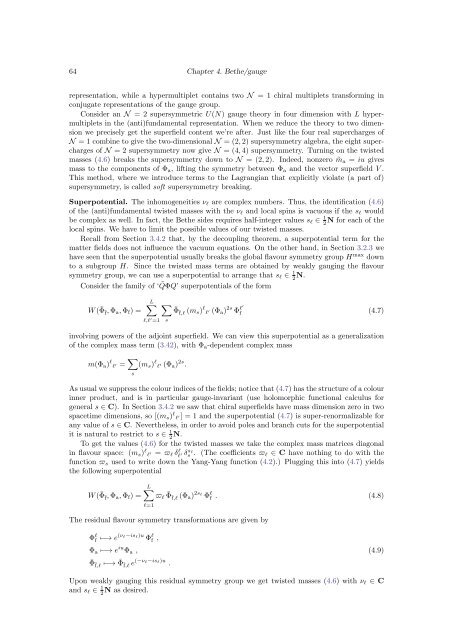The Bethe/Gauge Correspondence
The Bethe/Gauge Correspondence
The Bethe/Gauge Correspondence
You also want an ePaper? Increase the reach of your titles
YUMPU automatically turns print PDFs into web optimized ePapers that Google loves.
64 Chapter 4. <strong>Bethe</strong>/gaugerepresentation, while a hypermultiplet contains two N = 1 chiral multiplets transforming inconjugate representations of the gauge group.Consider an N = 2 supersymmetric U(N) gauge theory in four dimension with L hypermultipletsin the (anti)fundamental representation. When we reduce the theory to two dimensionwe precisely get the superfield content we’re after. Just like the four real supercharges ofN = 1 combine to give the two-dimensional N = (2, 2) supersymmetry algebra, the eight superchargesof N = 2 supersymmetry now give N = (4, 4) supersymmetry. Turning on the twistedmasses (4.6) breaks the supersymmetry down to N = (2, 2). Indeed, nonzero ˜m a = iu givesmass to the components of Φ a , lifting the symmetry between Φ a and the vector superfield V .This method, where we introduce terms to the Lagrangian that explicitly violate (a part of)supersymmetry, is called soft supersymmetry breaking.Superpotential. <strong>The</strong> inhomogeneities ν l are complex numbers. Thus, the identification (4.6)of the (anti)fundamental twisted masses with the ν l and local spins is vacuous if the s l wouldbe complex as well. In fact, the <strong>Bethe</strong> sides requires half-integer values s l ∈ 1 2N for each of thelocal spins. We have to limit the possible values of our twisted masses.Recall from Section 3.4.2 that, by the decoupling theorem, a superpotential term for thematter fields does not influence the vacuum equations. On the other hand, in Section 3.2.3 wehave seen that the superpotential usually breaks the global flavour symmetry group H max downto a subgroup H. Since the twisted mass terms are obtained by weakly gauging the flavoursymmetry group, we can use a superpotential to arrange that s l ∈ 1 2 N.Consider the family of ‘ ˜QΦQ’ superpotentials of the formW (¯Φ¯f, Φ a , Φ f ) =L∑l,l ′ =1∑s¯Φ¯f,l (m s ) l l ′ (Φ a) 2s Φ l′f (4.7)involving powers of the adjoint superfield. We can view this superpotential as a generalizationof the complex mass term (3.42), with Φ a -dependent complex massm(Φ a ) l l ′ = ∑ s(m s ) l l ′ (Φ a) 2s .As usual we suppress the colour indices of the fields; notice that (4.7) has the structure of a colourinner product, and is in particular gauge-invariant (use holomorphic functional calculus forgeneral s ∈ C). In Section 3.4.2 we saw that chiral superfields have mass dimension zero in twospacetime dimensions, so [(m s ) l l ′] = 1 and the superpotential (4.7) is super-renormalizable forany value of s ∈ C. Nevertheless, in order to avoid poles and branch cuts for the superpotentialit is natural to restrict to s ∈ 1 2 N.To get the values (4.6) for the twisted masses we take the complex mass matrices diagonalin flavour space: (m s ) l l ′ = ϖ l δl l ′ δs ls . (<strong>The</strong> coefficients ϖ l ∈ C have nothing to do with thefunction ϖ s used to write down the Yang-Yang function (4.2).) Plugging this into (4.7) yieldsthe following superpotentialW (¯Φ¯f, Φ a , Φ f ) =L∑ϖ l ¯Φ¯f,l (Φ a ) 2s lΦ l f . (4.8)l=1<strong>The</strong> residual flavour symmetry transformations are given byΦ l f ↦−→ e (ν l−is l )u Φ l f ,Φ a ↦−→ e iu Φ a ,¯Φ¯f,l ↦−→ ¯Φ¯f,l e (−ν l−is l )u .(4.9)Upon weakly gauging this residual symmetry group we get twisted masses (4.6) with ν l ∈ Cand s l ∈ 1 2N as desired.
















